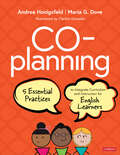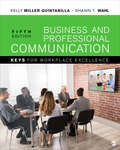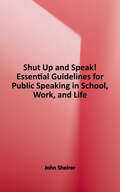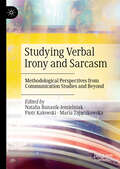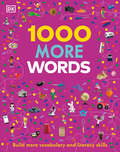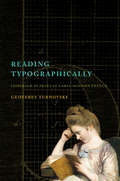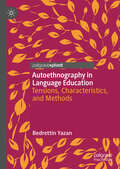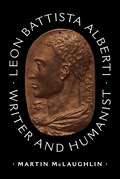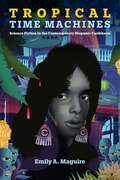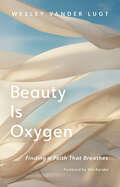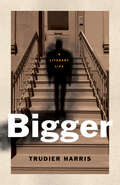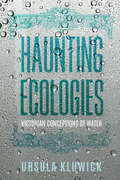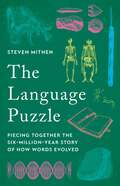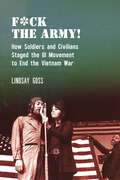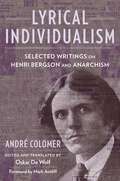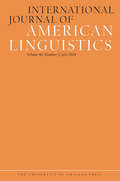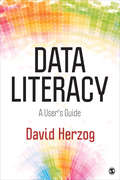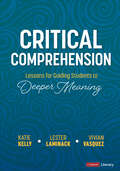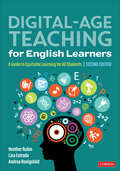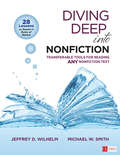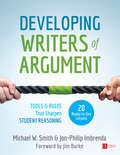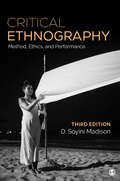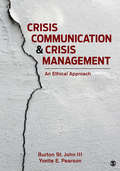- Table View
- List View
Co-Planning: Five Essential Practices to Integrate Curriculum and Instruction for English Learners
by Maria G. Dove Andrea HonigsfeldPool your collective wisdom in support of your English learners! English Learners (ELs) and multilingual learners (MLs) have double the work of their English-speaking peers as they are required to master language and content simultaneously. To support this dynamic academic and language development process, all teachers need to have an understanding of language acquisition and EL/ML-specific methodologies along with offering social-emotional support to ELs/MLs and work in tandem with each other. Bestselling authors Andrea Honigsfeld and Maria G. Dove have returned with this new resource that complements and expands on their previous titles on co-teaching and collaboration by addressing collaborative planning in greater depth. Co-planning is positioned as the first step toward integrative language and content instruction as regular and purposeful collaboration ensures that Els/MLs have access to core content. Key features include: • Practical, step-by-step guidance to starting and sustaining collaborative planning for integrated language, literacy, and social-emotional development • An array of checklists, templates, and protocols for immediate implementation • Snapshots from the Field provide real-life examples of co-planning in action • Beautiful full-color design with original sketch notes to bring concepts to life • QR codes that link to author interviews elaborating on key ideas This substantial guide will assist novice and seasoned educators alike in their move away from isolated practices and help them engage in collaborative planning and professional dialogue about asset-based, best practices for ELs/MLs.
Business and Professional Communication: KEYS for Workplace Excellence
by Shawn T. Wahl Kelly MillerOrganized around the transition from student to professional life, Business and Professional Communication, Fifth Edition gives readers the tools they need to move from interview candidate to team member to leader. Coverage of new communication technology and social media, and an emphasis on building skills for business writing and presentations help students gain a deeper understanding of the role of communication in successfully handling situations like job interviewing, providing feedback to supervisors, and working in teams. This title is accompanied by a complete teaching and learning package. Learning Platform / Courseware SAGE Vantage is an intuitive learning platform that integrates quality SAGE textbook content with assignable multimedia activities and auto-graded assessments to drive student engagement and ensure accountability. Unparalleled in its ease of use and built for dynamic teaching and learning, Vantage offers customizable LMS integration and best-in-class support. It’s a learning platform you, and your students, will actually love. Assignable Video with Assessment Assignable video (available in SAGE Vantage) is tied to learning objectives and curated exclusively for this text to bring concepts to life. LMS Cartridge: Import this title’s instructor resources into your school’s learning management system (LMS) and save time. Don’t use an LMS? You can still access all of the same online resources for this title via the password-protected Instructor Resource Site.
Shut Up and Speak!: Essential Guidelines for Public Speaking in School, Work, and Life
by John SheirerWhy does your mouth suddenly go dry, your throat tighten, your face gets hot, and your knees buckle when you have to address a group of people? The old story goes that more people are afraid of public speaking than they are of death. So people at a funeral would prefer to be the person in the casket than the person delivering the eulogy! Shut up and speak means that you must stop dwelling on how difficult or frightening public speaking is. Shut up and speak means that you can't become a better public speaker simply by studying communications theory or relying on public speaking folk wisdom. This book gives you the guidance to "shut up" by tuning out all of the interference that doesn't help you become a better public speaker and to "speak" by throwing yourself wholeheartedly into speech-making.
Studying Verbal Irony and Sarcasm: Methodological Perspectives from Communication Studies and Beyond
by Natalia Banasik-Jemielniak Piotr Kałowski Maria ZajączkowskaThis volume provides a comprehensive yet accessible introduction to the phenomenon of verbal irony and sarcasm and the methodological aspects of its study. The chapters employ quantitative and qualitative measures of the use of verbal irony and sarcasm in both adults and children, with methods ranging from questionnaires and comment elicitation through experimental studies to a qualitative analysis of naturalistic data. By examining the phenomena in a range of contexts, the volume also show that cultural norms of communication may affect both the use and understanding of irony in specific ways and should therefore be taken into account in research.
1000 More Words: Build More Vocabulary and Literacy Skills (Vocabulary Builders)
by Gill BudgellThis busy picture book broadens children's vocabulary and strengthens their language and literacy skills at home and at school.Written by language specialist Gill Budgell, the fun, picture-packed pages introduce key concepts to help children with early education subjects, such as music, geography, and computers. The book also strengthens children's language skills by exploring useful areas of linguistics in a fun and accessible way. Young readers can compare pictures of artistic materials to learn antonyms and spot the verbs in a busy gym class scene.1000 More Words clearly labels each picture, which encourages picture-and-word association and helps early reading. Each topic features questions that ask children to find things on the page or that stimulate thinking, talking, and reading comprehension skills.This fun and educational picture word book is a must-have first reference title for parents and guardians who are keen to develop their child's language and literacy skills, support their early years in education, and boost their confidence in communication.
Reading Typographically: Immersed in Print in Early Modern France (Stanford Text Technologies)
by Geoffrey TurnovskyAnxieties about the fate of reading in the digital age reveal how deeply our views of the moral and intellectual benefits of reading are tied to print. These views take root in a conception of reading as an immersive activity, exemplified by the experience of "losing oneself in a book." Against the backdrop of digital distraction and fragmentation, such immersion leads readers to become more focused, collected, and empathetic. How did we come to see the printed book as especially suited to deliver this experience? Print-based reading practices have historically included a wide range of modes, not least the disjointed scanning we associate today with electronic text. In the context of religious practice, literacy's benefits were presumed to lie in such random-access retrieval, facilitated by indexical tools like the numbering of Biblical chapters and verses. It was this didactic, hunt-and-peck reading that bound readers to communities. Exploring key evolutions in print in 17th- and 18th-century France, from typeface, print runs, and format to punctuation and the editorial adaptation of manuscript and oral forms in print, this book argues that typographic developments upholding the transparency of the printed medium were decisive for the ascendancy of immersive reading as a dominant paradigm that shaped modern perspectives on reading and literacy.
Autoethnography in Language Education: Tensions, Characteristics, and Methods
by Bedrettin YazanThis book presents an exploration of autoethnography in language education research as a qualitative method with the potential to decolonize language education practices and include marginalized scholars in knowledge generation. The author situates the method of autoethnography within the field, arguing that it has taken too long for autoethnography to be considered an established research method in language education in particular and in educational research in general. He then addresses tensions at the macro and micro levels of autoethnography, discusses its characteristics, and describes the processes and procedures involved in conducting autoethnographic research. This book will be of interest to graduate students and scholars in language education and related disciplines such as anthropology, communication studies, sociology, and broader educational research.
Leon Battista Alberti: Writer and Humanist
by Martin McLaughlinThe first book in English to examine Leon Battista Alberti&’s major literary works in Latin and Italian, which are often overshadowed by his achievements in architectureLeon Battista Alberti (1404–1472) was one of the most prolific and original writers of the Italian Renaissance—a fact often eclipsed by his more celebrated achievements as an art theorist and architect, and by Jacob Burckhardt&’s mythologizing of Alberti as a "Renaissance or Universal Man." In this book, Martin McLaughlin counters this partial perspective on Alberti, considering him more broadly as a writer dedicated to literature and humanism, a major protagonist and experimentalist in the literary scene of early Renaissance Italy. McLaughlin, a noted authority on Alberti, examines all of Alberti&’s major works in Latin and the Italian vernacular and analyzes his vast knowledge of classical texts and culture.McLaughlin begins with what we know of Alberti&’s life, comparing the facts laid out in Alberti&’s autobiography with the myth created in the nineteenth century by Burckhardt, before moving on to his extraordinarily wide knowledge of classical texts. He then turns to Alberti&’s works, tracing his development as a writer through texts that range from an early comedy in Latin successfully passed off as the work of a fictitious ancient author to later philosophical dialogues written in the Italian vernacular (a revolutionary choice at the time); humorous works in Latin, including the first novel in that language since antiquity; and the famous treatises on painting and architecture. McLaughlin also examines the astonishing range of Alberti's ancient sources and how this reading influenced his writing; what the humanist read, he argues, often explains what he wrote, and what he wrote reflected his relentless industry and pursuit of originality.
Tropical Time Machines: Science Fiction in the Contemporary Hispanic Caribbean (Reframing Media, Technology, and Culture in Latin/o America)
by Emily A. MaguireHow writers and artists use science fiction to speak to the current moment in the Caribbean Exploring the remarkable recent increase in works of science fiction originating in Spanish-speaking parts of the Caribbean and their diasporas, Tropical Time Machines shows how writers, filmmakers, musicians, and artists are using the language of the genre to comment on the region’s history and present-day realities. Discussing how previous Caribbean literature and film has characterized places including Cuba, Puerto Rico, and the Dominican Republic as “out of sync” with Western time, occupying a repeating or static space, Emily Maguire argues that science fiction breaks these cycles and resituates the region temporally and spatially. In chapters on cyberpunk, zombies, post-apocalyptic narratives, and the ab-real, Maguire shows how recent cultural production analyzes and critiques the ways globalization and national leadership have reinforced the region’s marginalization amid economic and climate crises. Art that employs the science fictional mode makes room for a new vision of the Caribbean, Maguire demonstrates—an alternate perspective in which the region has agency in shaping its own narratives and trajectories. The texts themselves are time machines, enabling creators to protest inequalities of the present from the point of view of an imagined, transformed future. A volume in the series Reframing Media, Technology, and Culture in Latin/o America, edited by Héctor Fernández L’Hoeste and Juan Carlos Rodríguez Publication of this work made possible by a Sustaining the Humanities through the American Rescue Plan grant from the National Endowment for the Humanities.
Beauty Is Oxygen: Finding a Faith That Breathes
by Wesley Vander LugtBeauty is oxygen because it comes from the lungs of God. Isolating individualism, rank injustice, and everyday monotony threaten to suffocate our souls. But Wesley Vander Lugt shows how beauty can breathe life back into us. Written in a graceful cadence that invites readers to turn these pages slowly, Beauty Is Oxygen weaves together theological reflection, poetry, cultural criticism, and Scripture. Throughout, Vander Lugt shows how beauty can break us out of self-centered malaise, promote healing and hope for our broken world, and reenchant our lives. Beauty is about more than positive feelings or pleasing aesthetics. Beauty is as essential to our souls as oxygen is to our bodies. As readers encounter these traces of divine glory in Vander Lugt&’s finely crafted meditations, they will find how Christ will &“make all things new.&”
Bigger: A Literary Life (Black Lives)
by Trudier HarrisA biography of Native Son&’s Bigger Thomas that examines his continued relevance in debates over Black men and the violence of racism Bigger Thomas, the central figure in Richard Wright&’s novel Native Son (1940), eludes easy categorization. A violent and troubled character who rejects the rules of society, Bigger is both victim and perpetrator, damaged by racism and segregation on the South Side of Chicago, seemingly raping and killing without regrets. His story has electrified readers for more than eight decades, and it continues to galvanize debates around representation, respectability, social justice, and racism in American life. In this book, distinguished scholar Trudier Harris examines the literary life of Bigger Thomas from his birth to the current day. Harris explores the debates between Black critics and Communist artists in the 1930s and 1940s over the &“political novel,&” the censorship of Native Son by white publishers, and the work&’s initial reception—as well as interpretations from Black feminists and Black Power activists in the decades that followed, up to the novel&’s resonance with the Black Lives Matter movement today. Bigger, Harris argues, represents the knotted heart of American racism, damning and unsettling, and still very much with us.
Haunting Ecologies: Victorian Conceptions of Water (Victorian Literature and Culture Series)
by Ursula KluwickVictorians&’ views of water and its role in how the social fabric of Victorian Britain was imagined Water matters like few other substances in people&’s daily lives. In the nineteenth century, it left its traces on politics, urban reform, and societal divisions, as well as on conceptualizations of gender roles. Drawing on the methodology of material ecocriticism, Ursula Kluwick&’s Haunting Ecologies argues that Victorian Britons were keenly aware of aquatic agency, recognizing water as an active force with the ability to infiltrate bodies and spaces. Kluwick reads works by canonical writers such as Braddon, Dickens, Stoker, and George Eliot alongside sanitary reform discourse, court cases, journalistic articles, satirical cartoons, technical drawings, paintings, and maps. This wide-ranging study sheds new light on Victorian-era anxieties about water contamination as well as on how certain wet landscapes such as sewers, rivers, and marshes became associated with moral corruption and crime. Applying ideas from the field of blue humanities to nineteenth-century texts, Haunting Ecologies argues for the relevance of realism as an Anthropocene form.
The Language Puzzle: Piecing Together the Six-Million-Year Story of How Words Evolved
by Steven MithenA top scholar reveals the most complete picture to date of how early human speech led to the languages we use today The emergence of language began with the apelike calls of our earliest ancestors. Today, the world is home to thousands of complex languages. Yet exactly how, when, and why this evolution occurred has been one of the most enduring—and contentiously debated—questions in science. In The Language Puzzle, renowned archaeologist Steven Mithen puts forward a groundbreaking new account of the origins of language. Scientists have gained new insights into the first humans of 2.8 million years ago, and how numerous species flourished but only one, Homo sapiens, survives today. Drawing from this work and synthesizing research across archaeology, psychology, linguistics, genetics, neuroscience, and more, Mithen details a step-by-step explanation of how our human ancestors transitioned from apelike calls to words, and from words to language as we use it today. He explores how language shaped our cognition and vice versa; how metaphor advanced Homo sapiens&’ ability to formulate abstract concepts, develop agriculture, and—ultimately—shape the world. The result is a master narrative that builds bridges between disciplines, stuns with its breadth and depth, and spans millennia of societal development. Deeply researched and brilliantly told, The Language Puzzle marks a seminal understanding of the evolution of language.
F*ck The Army!: How Soldiers and Civilians Staged the GI Movement to End the Vietnam War (Performance and American Cultures #7)
by Lindsay GossReveals the theatrical dimensions of civilian support for the revolutionary GI Movement of the 1960s-70sPerformance played a role both crucial and complicated in the antiwar activism of the 1960s and 1970s. As soldiers and civilian actors, activists, and celebrities worked together to end the Vietnam War, their theatrical acts of solidarity and resistance connected liberation struggles across the lines of race, gender, enlisted status, and nationality.F*ck The Army! offers the first, fully narrated history of the FTA, an antiwar variety show featuring Jane Fonda that played to tens of thousands of active-duty troops over the course of nine months in 1971. From its very conception, the civilian-led show was directed towards the project of making visible the growing antiwar movement organized by GIs, inspired by but also acting as a rebuttal to the increasingly out-of-touch USO tours presented by Bob Hope. Through an analysis of the FTA’s tactical performances of solidarity and resistance, Lindsay Goss brings into view the theatrical dimensions of the GI movement itself, revealing it as representative of the revolutionary and theatrical politics and tactics of the period. The volume highlights how, due to the movement’s subsequent historical erasure, a renewed anti-theatricality emerged from the 1960s and became a potent feature of contemporary political discourse.The author’s deft methodological and analytic strategies, in tandem with her elegantly accessible style demonstrate how seemingly little-known performance practices can activate consequential understandings of what we thought we knew about the recent past. At the same time, she encourages essential conversations about pressing contemporary issues that demand our attention. At its core, F*ck The Army! reveals the fundamentally theatrical character of radical activism when it seeks to challenge the status quo.
Millennial Jewish Stars: Navigating Racial Antisemitism, Masculinity, and White Supremacy
by Jonathan BranfmanHighlights how millennial Jewish stars symbolize national politics in US mediaJewish stars have longed faced pressure to downplay Jewish identity for fear of alienating wider audiences. But unexpectedly, since the 2000s, many millennial Jewish stars have won stellar success while spotlighting (rather than muting) Jewish identity. In Millennial Jewish Stars, Jonathan Branfman asks: what makes these explicitly Jewish stars so unexpectedly appealing? And what can their surprising success tell us about race, gender, and antisemitism in America? To answer these questions, Branfman offers case studies on six top millennial Jewish stars: the biracial rap superstar Drake, comedic rapper Lil Dicky, TV comedy duo Abbi Jacobson and Ilana Glazer, “man-baby” film star Seth Rogen, and chiseled film star Zac Efron.Branfman argues that despite their differences, each star’s success depends on how they navigate racial antisemitism: the historical notion that Jews are physically inferior to Christians. Each star especially navigates racial stigmas about Jewish masculinity—stigmas that depict Jewish men as emasculated, Jewish women as masculinized, and both as sexually perverse. By embracing, deflecting, or satirizing these stigmas, each star comes to symbolize national hopes and fears about all kinds of hot-button issues. For instance, by putting a cuter twist on stereotypes of Jewish emasculation, Seth Rogen plays soft man-babies who dramatize (and then resolve) popular anxieties about modern fatherhood. This knack for channeling national dreams and doubts is what makes each star so unexpectedly marketable.In turn, examining how each star navigates racial antisemitism onscreen makes it easier to pinpoint how antisemitism, white privilege, and color-based racism interact in the real world. Likewise, this insight can aid readers to better notice and challenge racial antisemitism in everyday life.
Lyrical Individualism: Selected Writings on Henri Bergson and Anarchism (Columbia Themes in Philosophy, Social Criticism, and the Arts)
by Andre ColomerIn the early twentieth century, André Colomer was perhaps the best-known figure in the anarchist movement. A poet, philosopher, activist, and public speaker, he was enmeshed in the Parisian political and artistic scene at a time of political and cultural revolution. Amid the avant-garde explosions of Cubism, futurism, and surrealism and the ferment of radical politics on left and right, Colomer became anarchism’s leading advocate. He galvanized the Parisian public through his agitational writing and organizing, as well as his involvement in a sensational murder case, while developing a distinctive philosophical account of anarchist individualism. Yet Colomer died in obscurity in Moscow, abandoned by his friends and comrades, and is scarcely known in the English-speaking world today.Lyrical Individualism presents a selection of Colomer’s crucial writings, with a focus on anarchist theory and the philosophy of Henri Bergson. It reveals the richness of Colomer’s philosophical work, particularly his creative engagement with Bergson, Max Stirner, and Friedrich Nietzsche to forge a novel anarchist ideology. Colomer’s writings not only offer valuable insights into interwar anarchism, they also present a distinctive philosophical vision that in many ways anticipates theories and debates animating radical political movements today. This book also showcases his acerbic and pugnacious political commentary on the turbulent events of the 1910s and 1920s. The first translation and publication of Colomer’s work since his untimely death in 1931, Lyrical Individualism allows a range of readers to discover this vital thinker.
International Journal of American Linguistics, volume 90 number 3 (July 2024)
by International Journal of American LinguisticsThis is volume 90 issue 3 of International Journal of American Linguistics. The International Journal of American Linguistics (IJAL) is dedicated to the documentation and analysis of the indigenous languages of the Americas. Founded by Franz Boas and Pliny Earle Goddard in 1917, the journal focuses on the linguistics of American Indigenous languages. IJAL is an important repository for research based on field work and archival materials on the languages of North and South America.
Data Literacy: A User′s Guide
by David L. HerzogA practical, skill-based introduction to data analysis and literacy We are swimming in a world of data, and this handy guide will keep you afloat while you learn to make sense of it all. In Data Literacy: A User′s Guide, David Herzog, a journalist with a decade of experience using data analysis to transform information into captivating storytelling, introduces students and professionals to the fundamentals of data literacy, a key skill in today’s world. Assuming the reader has no advanced knowledge of data analysis or statistics, this book shows how to create insight from publicly-available data through exercises using simple Excel functions. Extensively illustrated, step-by-step instructions within a concise, yet comprehensive, reference will help readers identify, obtain, evaluate, clean, analyze and visualize data. A concluding chapter introduces more sophisticated data analysis methods and tools including database managers such as Microsoft Access and MySQL and standalone statistical programs such as SPSS, SAS and R.
Critical Comprehension [Grades K-6]: Lessons for Guiding Students to Deeper Meaning (Corwin Literacy)
by Lester Laminack Vivian Maria Vasquez Katie KellyBecause high-level comprehension cannot be divorced from wide-ranging texts To be literate is to think through multiple perspectives, exploring diverse texts, and using the power of story to give students the life skills to discuss just about anything with critical curiosity. Critical Comprehension transforms this vital work into an accessible, three-step lesson process. Using picture books, multimodal texts, and thoughtfully framed questions, each differentiated lesson expands students’ understanding of a text through: First read: the "movie read", during which the text is read without interruption Second read: The teacher poses questions that probe deeper meanings through interaction with the text to summarize, name and highlight issues, analyze and infer, to make more informed decisions about what to believe and what to question. Third read: Harnessing students’ curiosities, the class revisits the text to talk back to theme, symbols, central idea, or social, cultural, historical influences at work on author and audience Popular media, classic novels, breaking news — the world’s content is ready for students to absorb. But are we ready to help them read it well? Equipped with this resource, the answer is, Yes, we are.
Digital-Age Teaching for English Learners: A Guide to Equitable Learning for All Students
by Lisa M. Estrada Andrea Honigsfeld Heather RubinBridge the Digital Divide with Research-Informed Technology Models Since the first edition of this bestselling resource many schools are still striving to close the digital divide and bridge the opportunity gap for historically marginalized students, including English learners. And the need for technology-infused lessons specifically aligned for English learners is even more critically needed. Building from significant developments in education policy, research, and remote learning innovations, this newly revised edition offers unique ways to bridge the digital divide that disproportionally affects culturally and linguistically diverse learners. Designed to support equitable access to engaging and enriching digital-age education opportunities for English learners, this book includes Research-informed and evidence-based technology integration models and instructional strategies Sample lesson ideas, including learning targets for activating students’ prior knowledge while promoting engagement and collaboration Tips for fostering collaborative practices with colleagues Vignettes from educators incorporating technology in creative ways Targeted questions to facilitate discussions about English language development methodology Complete with supplementary tools and resources, this guide provides all of the methodology resources needed to bridge the digital divide and promote learning success for all students.
Diving Deep Into Nonfiction, Grades 6-12: Transferable Tools for Reading ANY Nonfiction Text (Corwin Literacy)
by Michael W. Smith Jeffrey D. Wilhelm"General reading strategies and teacher-developed questions will only take our students so far—with our approach, students gain astounding independence because they engage directly with the nonfiction author, and with how that author used specific details (moves) and structures to communicate meanings and effects." —Wilhelm and Smith All nonfiction is a conversation between the writer and the reader, an invitation to agree or disagree with compelling and often provocative ideas about some aspect of the world we live in. At the end of the day, it’s our responsibility to decide if the argument is sound. With Diving Deep Into Nonfiction, Jeffrey D. Wilhelm and Michael W. Smith deliver a revolutionary teaching framework that helps students read well by noticing the rules and conventions of this dynamic exchange. The classroom-tested lessons include engaging short excerpts and teach students to be powerful readers who know both how authors signal what’s worth noticing in a text and how readers connect and make meaning of what they have noticed. No matter what they are reading, students learn to be on high alert, and highly curious about how texts work and what they mean, as they learn to notice direct statements of principle, calls to attention, ruptures, and readers’ rules of notice: Notice the topics and the textual conversation: Who is speaking and how might he or she be responding to another’s ideas? What is the idea that gives "heat" to this text? Notice key details: What attracts my attention? How does the author signal both direct and implicit statements of meaning? How does the author use the unexpected? How can I interpret patterns of key details to see overall meanings? Notice varied nonfiction genres: What are the essential features of this kind of text? How does the author employ them? What effects are they designed to have on the reader? Notice text structure: How does the author structure the text to connect details and ideas? What patterns of thought does the author use along the way? With Diving Deep Into Nonfiction, Wilhelm and Smith upend current practices, and it’s high time. Once your students engage with these lessons, you’ll never go back to the same old tired approach— and reading across content areas enters a whole new era.
Developing Writers of Argument: Tools and Rules That Sharpen Student Reasoning (Corwin Literacy)
by Michael W. Smith Jon-Philip ImbrendaThe ability to make effective arguments is not only necessary in students’ academic lives, it’s a transferable skill that’s essential to students’ future success as critical thinkers and contributing members of society. But in the here and now, how do we engage students and ensure they understand argument writing’s fundamental components? How do we take them from "Here’s what I think" to "Here’s what I think. Here’s what makes me think that. And here’s why it matters"? This stunning, full-color book by Michael Smith and Jon-Philip Imbrenda shows the way, with ready-to-implement lessons that make argument writing topical and relevant. Students are first asked to form arguments about subjects that matter to them, and then to reflect on the structure of those arguments, a process that provides learners with valuable, reusable structural models. Throughout the book, the authors provide helpful instructional tools, including Literary, nonfiction, and author-created simulated texts that inspire different points of view Essential questions to create a context that rewards argumentation Lessons introducing students to the three essential elements of an argument—claim, data, and warrant—and how to make each effective Questioning probes, semantic differential scales, and other innovative instructional approaches Samples of writing from the authors’ own students, and enlightening details on how this work informed the authors’ subsequent teaching approach Complete with guidance on applying the lessons’ techniques in a broader, unit-wide context, Developing Writers of Argument offers a practical approach for instructing students in this crucial aspect of their lifelong development.
Developing Writers of Argument: Tools and Rules That Sharpen Student Reasoning (Corwin Literacy)
by Michael W. Smith Jon-Philip ImbrendaThe ability to make effective arguments is not only necessary in students’ academic lives, it’s a transferable skill that’s essential to students’ future success as critical thinkers and contributing members of society. But in the here and now, how do we engage students and ensure they understand argument writing’s fundamental components? How do we take them from "Here’s what I think" to "Here’s what I think. Here’s what makes me think that. And here’s why it matters"? This stunning, full-color book by Michael Smith and Jon-Philip Imbrenda shows the way, with ready-to-implement lessons that make argument writing topical and relevant. Students are first asked to form arguments about subjects that matter to them, and then to reflect on the structure of those arguments, a process that provides learners with valuable, reusable structural models. Throughout the book, the authors provide helpful instructional tools, including Literary, nonfiction, and author-created simulated texts that inspire different points of view Essential questions to create a context that rewards argumentation Lessons introducing students to the three essential elements of an argument—claim, data, and warrant—and how to make each effective Questioning probes, semantic differential scales, and other innovative instructional approaches Samples of writing from the authors’ own students, and enlightening details on how this work informed the authors’ subsequent teaching approach Complete with guidance on applying the lessons’ techniques in a broader, unit-wide context, Developing Writers of Argument offers a practical approach for instructing students in this crucial aspect of their lifelong development.
Critical Ethnography: Method, Ethics, and Performance
by D. Soyini Madison"Critical Ethnography is a rare and beautiful synthesis of deft theorizing and principled pragmatics. The complexities of ethnography demand a grasp of both theory and practice, but rarely have they come together so clearly and completely as in this passionately written text. I especially appreciate the thoughtful attention to the intellectual roots of the critical tradition in ethnography, and to the way students are rigorously led through the methodological consequences of critical epistemology." —Judith Hamera, Texas A&M University "I would strongly recommend this book for use in any course that explores the role of critical analysis in research. This book thoughtfully discusses and teaches about trying to understand the meanings attributed by others in regard to their expertise." —Amy Paul-Ward, Florida International University What is critical ethnography? How do we use theory to interpret research data? What is performance ethnography? Readers can find answers to these fundamental questions in D. Soyini Madison′s engaging and highly multidisciplinary Third Edition of Critical Ethnography: Methods, Ethics, and Performance. The book presents a fresh new look at critical ethnography by emphasizing the significance of ethics and performance in the art and politics of fieldwork. The productive links between theory and method are celebrated in this title. Theoretical concepts range from queer theory, feminist theory, and critical race theory to Marxism and phenomenology. The methodological techniques range from designing and asking in-depth interview questions and developing rapport to coding and interpreting data. The various theories and methods culminate in three fictional ethnographic case studies that "enact" the interdependence between theory and method and the significance of social theory, ethics, and performance.
Crisis Communication and Crisis Management: An Ethical Approach
by Yvette E. Pearson Burton St. JohnCrisis Communication and Crisis Management: An Ethical Approach is the only text on the market to provide students with the integration of ethical inquiry into the fundamentals of crisis communication.. Authors Burton St. John III and Yvette E. Pearson combine comprehensive coverage of the key skills, concepts, and theories of crisis communication with an extensive collection of contemporary case studies, giving students a strong understanding of the essential role that communicators play in moments of crisis. Students are encouraged to build upon their communication and ethical decision making skills using a variety of stakeholder inventories, hypothetical scenarios, discussion questions, and professional profiles. Students will also gain exposure to a mixture of discrete and ongoing crises, preparing them to manage both one-time crises and continuing crises.
